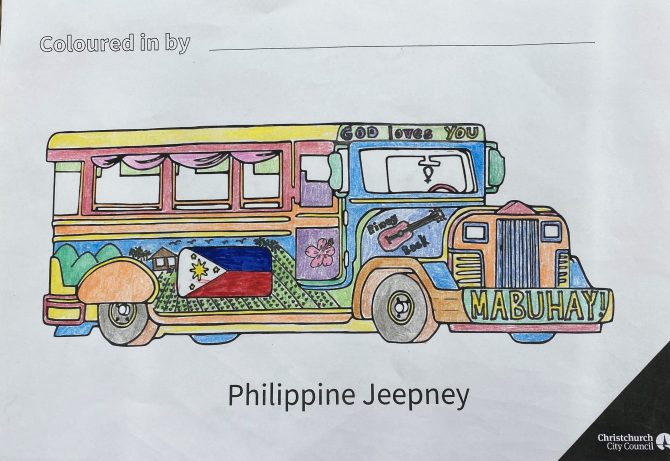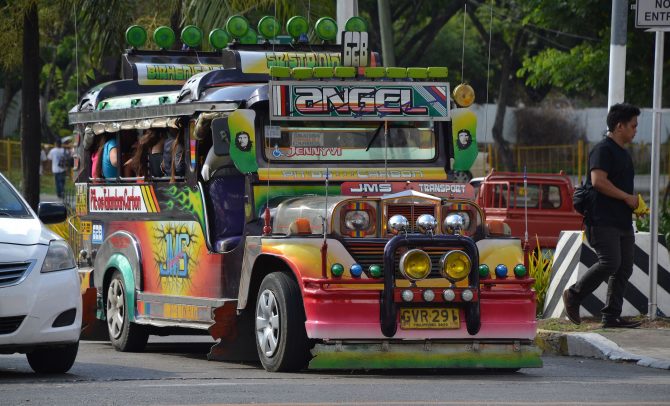If you visit the Philippines especially the main cities like Manila, you can’t miss it: the Pinoy jeepney. Coated in wild colours and adorned with flashy ornaments, this flamboyant elongated jeep is considered a Filipino icon as it is made and found only in the Philippines. It is also the most popular public transportation in the country, hence it's called the Philippines' "King of the Road".
Pinoy jeepneys were first made in 1945, just after World War II. To solve the then mass transportation problem, Filipinos upcycled the surplus jeeps brought to the Philippines by American troops. They extended the jeeps to accommodate 10 to 25 passengers and installed open windows on all sides as well as a fixed roof as protection from the extreme Philippine heat. The Pinoy jeepney thus reflects the ingenuity, resourcefulness, and resilience of Filipinos.
The Pinoy jeepney also displays the Filipinos' jovial spirit and artistry. Jeepney manufacturers like the famous Sarao Motors even employ "jeepney artists” to paint the vehicles with striking colours and artworks depicting Philippine landscapes, life, and culture from religious icons and emblems to tourist spots. Inspiring quotes and names of loved ones are also painted on the vehicles if requested by the buyers. Jeepney drivers further decorate their dashboards with fancy accessories from rosaries and family pictures to gaudy ribbons.
So unique is the Pinoy jeepney that it had been exhibited in the 1964 New York World’s Fair and in European roadshows as a Philippine symbol. Just like the country it represents, the Pinoy jeepney has withstood time but today, its existence is being threatened by recent calls from politicians to phase it out. For now, however, similar to the resilient passengers it has carried for 85 years, this King of the Road continues to roll on and rule the Philippine streets.
Ang Pinoy Dyipni: Hari ng Kalsada
Kung bibisita ka sa Pilipinas, lalo na sa mga progresibong lungsod katulad ng Maynila, imposibleng hindi mo ito mapapansin: ang makulay at mapalamuting Pinoy dyipni. Matatagpuan lamang sa Pilipinas, tinawag itong “Hari ng Kalsada” dahil ito ang pinakasikat na pampublikong sasakyan sa bansa.
Itinuturing bilang isang simbulo ng kulturang Pilipino, nagsimula ang paggawa ng mga Pinoy dyipni taong 1945 noong katatapos lamang ng Ikalawang Digmaang Pandaigdig. Dahil sa pangmalawakang problema noon sa transportasyon, binago ng mga Pilipino ang istilo ng mga dyip na dinala ng mga Amerikanong sundalo. Pinahaba nila ang mga sasakyang ito upang magkasya ang sampu hanggang dalawapu’t limang pasahero. Nilagyan din nila ang mga ito ng mga bukas na bintana at permanenteng bubong bilang proteksiyon sa mainit na araw sa Pilipinas. Samakatuwid, ang Pinoy dyipni ay naglalarawan ng galing sa paglikha, pagiging madiskarte at matatag ng mga Pilipino.
Ipinapakita din ng mga Pinoy dyipni ang pagiging masayahin at masining ng mga Pilipino. Ang mga kumpanyang gumagawa ng mga dyipni katulad ng sikat na Sarao Motors ay kumukuha pa ng mga "jeepney artists" upang pintahan ang mga dyip ng iba’t ibang kulay at ng mga imaheng naglalarawan ng buhay at kultura sa Pilipinas. Nilalagyan din ng mga drayber ang kanilang mga dyipni ng mga magagarang palamuti katulad ng rosaryo, laso, at mga larawan ng kanilang mga mahal sa buhay.
Dahil ito ay tunay na kakaiba, itinampok pa ang Pinoy Dyipni sa 1964 New York’s World Fair bilang simbulo ng Pilipinas. Katulad ng bansang kinakatawan nito, subok na ng panahon ang Pinoy dyipni ngunit sa kasalukuyan, may mga panawagan ang mga politiko na ito’y ipagbawal na sa kalye. Pero katulad din ng mga Pilipinong pasahero na pinagsilbihan nito ng walumpu’t limang taon, nanatiling itong matibay at patuloy na sumusulong- isang tunay na “Hari ng Kalsada.”
Challenge: Jazz Up Your Jeepney
- Download and print the Pinoy jeepney template below or draw your own jeepney by watching this video : How to Draw the Jeepney of the Philippines
- Draw images or write words on your jeepney
- Colour it with as bright colours as you can








Add a comment to: The Pinoy Jeepney: the Philippines’ King of the Road